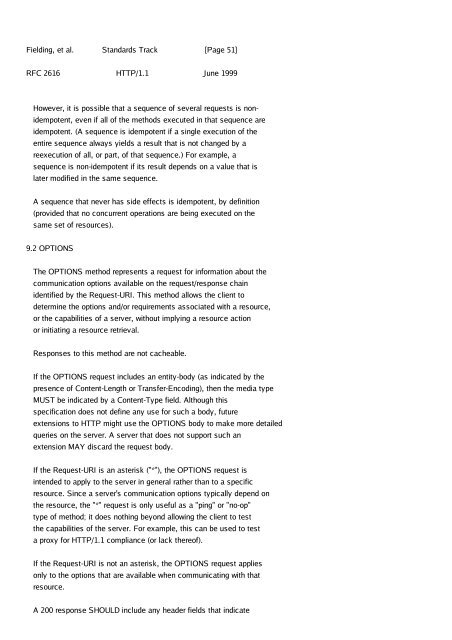Network Working Group R. Fielding Request for Comments: 2616 ...
Network Working Group R. Fielding Request for Comments: 2616 ...
Network Working Group R. Fielding Request for Comments: 2616 ...
Create successful ePaper yourself
Turn your PDF publications into a flip-book with our unique Google optimized e-Paper software.
<strong>Fielding</strong>, et al. Standards Track [Page 51]RFC <strong>2616</strong> HTTP/1.1 June 1999However, it is possible that a sequence of several requests is nonidempotent,even if all of the methods executed in that sequence areidempotent. (A sequence is idempotent if a single execution of theentire sequence always yields a result that is not changed by areexecution of all, or part, of that sequence.) For example, asequence is non-idempotent if its result depends on a value that islater modified in the same sequence.A sequence that never has side effects is idempotent, by definition(provided that no concurrent operations are being executed on thesame set of resources).9.2 OPTIONSThe OPTIONS method represents a request <strong>for</strong> in<strong>for</strong>mation about thecommunication options available on the request/response chainidentified by the <strong>Request</strong>-URI. This method allows the client todetermine the options and/or requirements associated with a resource,or the capabilities of a server, without implying a resource actionor initiating a resource retrieval.Responses to this method are not cacheable.If the OPTIONS request includes an entity-body (as indicated by thepresence of Content-Length or Transfer-Encoding), then the media typeMUST be indicated by a Content-Type field. Although thisspecification does not define any use <strong>for</strong> such a body, futureextensions to HTTP might use the OPTIONS body to make more detailedqueries on the server. A server that does not support such anextension MAY discard the request body.If the <strong>Request</strong>-URI is an asterisk ("*"), the OPTIONS request isintended to apply to the server in general rather than to a specificresource. Since a server's communication options typically depend onthe resource, the "*" request is only useful as a "ping" or "no-op"type of method; it does nothing beyond allowing the client to testthe capabilities of the server. For example, this can be used to testa proxy <strong>for</strong> HTTP/1.1 compliance (or lack thereof).If the <strong>Request</strong>-URI is not an asterisk, the OPTIONS request appliesonly to the options that are available when communicating with thatresource.A 200 response SHOULD include any header fields that indicate













